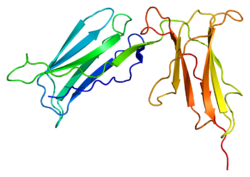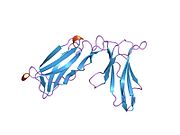Killer cell immunoglobulin-like receptor 2DL1 is a protein that in humans is encoded by the KIR2DL1 gene.[3][4][5]
Function[edit]
Killer-cell immunoglobulin-like receptors (KIRs) are transmembrane glycoproteins expressed by natural killer cells and subsets of T cells. The KIR genes are polymorphic and highly homologous and they are found in a cluster on chromosome 19q13.4 within the 1 Mb leukocyte receptor complex (LRC). The gene content of the KIR gene cluster varies among haplotypes, although several "framework" genes are found in all haplotypes (KIR3DL3, KIR3DP1, KIR2DL4, KIR3DL2). The KIR proteins are classified by the number of extracellular immunoglobulin domains (2D or 3D) and by whether they have a long (L) or short (S) cytoplasmic domain. KIR proteins with the long cytoplasmic domain transduce inhibitory signals upon ligand binding via an immune tyrosine-based inhibitory motif (ITIM), while KIR proteins with the short cytoplasmic domain lack the ITIM motif and instead associate with the TYRO protein tyrosine kinase binding protein to transduce activating signals. The ligands for several KIR proteins are subsets of HLA class I molecules; thus, KIR proteins are thought to play an important role in regulation of the immune response.[5]
Interactions[edit]
KIR2DL1 has been shown to interact with HLA-C.[6][7][8][9]
See also[edit]
References[edit]
- ^ a b c ENSG00000275196, ENSG00000278805, ENSG00000125498, ENSG00000284401, ENSG00000278755, ENSG00000278495, ENSG00000278738, ENSG00000278248, ENSG00000278503, ENSG00000284530, ENSG00000276820, ENSG00000275080, ENSG00000275276, ENSG00000273794, ENSG00000276625, ENSG00000277616, ENSG00000284100, ENSG00000284514, ENSG00000283723, ENSG00000274926, ENSG00000278207, ENSG00000274782, ENSG00000284347, ENSG00000273510, ENSG00000274692, ENSG00000277833, ENSG00000276310, ENSG00000284551, ENSG00000275750, ENSG00000275522, ENSG00000277356, ENSG00000284145 GRCh38: Ensembl release 89: ENSG00000278821, ENSG00000275196, ENSG00000278805, ENSG00000125498, ENSG00000284401, ENSG00000278755, ENSG00000278495, ENSG00000278738, ENSG00000278248, ENSG00000278503, ENSG00000284530, ENSG00000276820, ENSG00000275080, ENSG00000275276, ENSG00000273794, ENSG00000276625, ENSG00000277616, ENSG00000284100, ENSG00000284514, ENSG00000283723, ENSG00000274926, ENSG00000278207, ENSG00000274782, ENSG00000284347, ENSG00000273510, ENSG00000274692, ENSG00000277833, ENSG00000276310, ENSG00000284551, ENSG00000275750, ENSG00000275522, ENSG00000277356, ENSG00000284145 - Ensembl, May 2017
- ^ "Human PubMed Reference:". National Center for Biotechnology Information, U.S. National Library of Medicine.
- ^ Wagtmann N, Biassoni R, Cantoni C, Verdiani S, Malnati MS, Vitale M, Bottino C, Moretta L, Moretta A, Long EO (June 1995). "Molecular clones of the p58 NK cell receptor reveal immunoglobulin-related molecules with diversity in both the extra- and intracellular domains". Immunity. 2 (5): 439–49. doi:10.1016/1074-7613(95)90025-X. PMID 7749980.
- ^ Colonna M, Samaridis J (May 1995). "Cloning of immunoglobulin-superfamily members associated with HLA-C and HLA-B recognition by human natural killer cells". Science. 268 (5209): 405–8. Bibcode:1995Sci...268..405C. doi:10.1126/science.7716543. PMID 7716543.
- ^ a b "Entrez Gene: KIR2DL1 killer cell immunoglobulin-like receptor, two domains, long cytoplasmic tail, 1".
- ^ Boyson JE, Erskine R, Whitman MC, Chiu M, Lau JM, Koopman LA, Valter MM, Angelisova P, Horejsi V, Strominger JL (December 2002). "Disulfide bond-mediated dimerization of HLA-G on the cell surface". Proc. Natl. Acad. Sci. U.S.A. 99 (25): 16180–5. Bibcode:2002PNAS...9916180B. doi:10.1073/pnas.212643199. PMC 138585. PMID 12454284.
- ^ Baba E, Erskine R, Boyson JE, Cohen GB, Davis DM, Malik P, Mandelboim O, Reyburn HT, Strominger JL (December 2000). "N-linked carbohydrate on human leukocyte antigen-C and recognition by natural killer cell inhibitory receptors". Hum. Immunol. 61 (12): 1202–18. doi:10.1016/S0198-8859(00)00184-1. PMID 11163076.
- ^ Valés-Gómez M, Reyburn HT, Mandelboim M, Strominger JL (September 1998). "Kinetics of interaction of HLA-C ligands with natural killer cell inhibitory receptors". Immunity. 9 (3): 337–44. doi:10.1016/S1074-7613(00)80616-0. PMID 9768753.
- ^ Fan QR, Long EO, Wiley DC (May 2001). "Crystal structure of the human natural killer cell inhibitory receptor KIR2DL1-HLA-Cw4 complex". Nat. Immunol. 2 (5): 452–60. doi:10.1038/87766. PMID 11323700. S2CID 24707532.
Further reading[edit]
- Fan QR, Mosyak L, Winter CC, Wagtmann N, Long EO, Wiley DC (1997). "Structure of the inhibitory receptor for human natural killer cells resembles haematopoietic receptors". Nature. 389 (6646): 96–100. Bibcode:1997Natur.389...96F. doi:10.1038/38028. PMID 9288975. S2CID 4365964.
- Kim J, Chwae YJ, Kim MY, Choi IH, Park JH, Kim SJ (1997). "Molecular basis of HLA-C recognition by p58 natural killer cell inhibitory receptors". J. Immunol. 159 (8): 3875–82. doi:10.4049/jimmunol.159.8.3875. PMID 9378975. S2CID 21878260.
- Valiante NM, Uhrberg M, Shilling HG, Lienert-Weidenbach K, Arnett KL, D'Andrea A, Phillips JH, Lanier LL, Parham P (1998). "Functionally and structurally distinct NK cell receptor repertoires in the peripheral blood of two human donors". Immunity. 7 (6): 739–51. doi:10.1016/S1074-7613(00)80393-3. PMID 9430220.
- Uhrberg M, Valiante NM, Shum BP, Shilling HG, Lienert-Weidenbach K, Corliss B, Tyan D, Lanier LL, Parham P (1998). "Human diversity in killer cell inhibitory receptor genes". Immunity. 7 (6): 753–63. doi:10.1016/S1074-7613(00)80394-5. PMID 9430221.
- Rajagopalan S, Long EO (1998). "Zinc bound to the killer cell-inhibitory receptor modulates the negative signal in human NK cells". J. Immunol. 161 (3): 1299–305. doi:10.4049/jimmunol.161.3.1299. PMID 9686591.
- Valés-Gómez M, Reyburn HT, Mandelboim M, Strominger JL (1998). "Kinetics of interaction of HLA-C ligands with natural killer cell inhibitory receptors". Immunity. 9 (3): 337–44. doi:10.1016/S1074-7613(00)80616-0. PMID 9768753.
- Shilling HG, Lienert-Weidenbach K, Valiante NM, Uhrberg M, Parham P (1998). "Evidence for recombination as a mechanism for KIR diversification". Immunogenetics. 48 (6): 413–6. doi:10.1007/s002510050453. PMID 9799338. S2CID 11887627.
- Chwae YJ, Cho SE, Kim SJ, Kim J (1999). "Diversity of the repertoire of p58 killer cell inhibitory receptors in a single individual". Immunol. Lett. 68 (2–3): 267–74. doi:10.1016/S0165-2478(99)00062-0. PMID 10424431.
- Fan QR, Wiley DC (1999). "Structure of human histocompatibility leukocyte antigen (HLA)-Cw4, a ligand for the KIR2D natural killer cell inhibitory receptor". J. Exp. Med. 190 (1): 113–23. doi:10.1084/jem.190.1.113. PMC 2195553. PMID 10429675.
- Richardson J, Reyburn HT, Luque I, Valés-Gómez M, Strominger JL (2000). "Definition of polymorphic residues on killer Ig-like receptor proteins which contribute to the HLA-C binding site". Eur. J. Immunol. 30 (5): 1480–5. doi:10.1002/(SICI)1521-4141(200005)30:5<1480::AID-IMMU1480>3.0.CO;2-7. PMID 10820396.
- Fan QR, Long EO, Wiley DC (2000). "A disulfide-linked natural killer cell receptor dimer has higher affinity for HLA-C than wild-type monomer". Eur. J. Immunol. 30 (9): 2692–7. doi:10.1002/1521-4141(200009)30:9<2692::AID-IMMU2692>3.0.CO;2-0. PMID 11009104.
- Baba E, Erskine R, Boyson JE, Cohen GB, Davis DM, Malik P, Mandelboim O, Reyburn HT, Strominger JL (2001). "N-linked carbohydrate on human leukocyte antigen-C and recognition by natural killer cell inhibitory receptors". Hum. Immunol. 61 (12): 1202–18. doi:10.1016/S0198-8859(00)00184-1. PMID 11163076.
- Rajalingam R, Gardiner CM, Canavez F, Vilches C, Parham P (2001). "Identification of seventeen novel KIR variants: fourteen of them from two non-Caucasian donors". Tissue Antigens. 57 (1): 22–31. doi:10.1034/j.1399-0039.2001.057001022.x. PMID 11169255.
- Fan QR, Long EO, Wiley DC (2001). "Crystal structure of the human natural killer cell inhibitory receptor KIR2DL1-HLA-Cw4 complex". Nat. Immunol. 2 (5): 452–60. doi:10.1038/87766. PMID 11323700. S2CID 24707532.
- Guerra N, Michel F, Gati A, Gaudin C, Mishal Z, Escudier B, Acuto O, Chouaib S, Caignard A (2002). "Engagement of the inhibitory receptor CD158a interrupts TCR signaling, preventing dynamic membrane reorganization in CTL/tumor cell interaction". Blood. 100 (8): 2874–81. doi:10.1182/blood-2002-02-0643. PMID 12351398.
- Spaggiari GM, Contini P, Dondero A, Carosio R, Puppo F, Indiveri F, Zocchi MR, Poggi A (2003). "Soluble HLA class I induces NK cell apoptosis upon the engagement of killer-activating HLA class I receptors through FasL-Fas interaction". Blood. 100 (12): 4098–107. doi:10.1182/blood-2002-04-1284. PMID 12393468.
- Boyson JE, Erskine R, Whitman MC, Chiu M, Lau JM, Koopman LA, Valter MM, Angelisova P, Horejsi V, Strominger JL (2003). "Disulfide bond-mediated dimerization of HLA-G on the cell surface". Proc. Natl. Acad. Sci. U.S.A. 99 (25): 16180–5. Bibcode:2002PNAS...9916180B. doi:10.1073/pnas.212643199. PMC 138585. PMID 12454284.
This article incorporates text from the United States National Library of Medicine, which is in the public domain.









